Liquor trends in central Iowa
6/5/2024It’s no secret that Iowans enjoy an adult beverage. Or two. While alcohol can have its drawbacks, and should be consumed responsibly, drinking has become ingrained in Iowa culture.
Iowa State football fans have made a habit out of drinking mass quantities of Busch Light at bars in whichever cities host their bowl games. Their Liberty Bowl game against Memphis in 2017 caused future venues to stock up on extras. Iowa women’s basketball fans drank one of the city’s most popular bars, Brothers, out of the same hoppy beverage during the Elite Eight game against LSU in Caitlin Clark’s record-breaking run just a few months ago.
It’s no secret that many college students drink alcohol, and it is not much of a secret that the average Iowan enjoys it as well. That’s where the numbers come in.
The Iowa Alcohol and Tax Operations Division (IATOD), which was formerly the Iowa Alcoholic Beverages Division, governs the sales and use of alcohol in Iowa. IATOD releases an annual report on sales and gallons consumed of alcoholic beverages. The report provides a look inside the average Iowan’s liquor cabinet and what is stocking the bar carts.
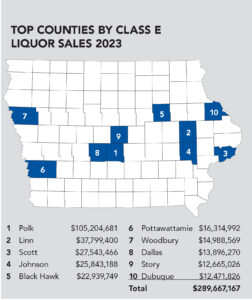 Behind the numbers
Behind the numbers
The IATOD reported total revenue of $478,259,852 in 2023, a 3.34% increase from 2022. Unsurprisingly, $445,830,313 of that came from liquor sales. Of the top 10 counties that made up for $289,667,167 in Class E liquor sales, Polk County was responsible for more than $105 million. That’s nearly three times as much as the second-place county, Linn. While sales increased from 2022, what might surprise people is that Iowans cut back their consumption of wine and beer. To get a better idea of the why, how and what is behind these numbers, we spoke with Leisa Bertram, the Bureau Chief of Alcohol Operations and Finance at the IATOD.
“We report on what we sell wholesale to the retailers, and then the retailers can sell wholesale to bars, restaurants, or they can sell retail to the public,” Bertram said.
For liquor brands, Tito’s Handmade Vodka recently usurped Black Velvet’s Canadian Whiskey as the top brand in Iowa for gallons sold. Bertram points to a number of reasons why that might be.
“As a brand, they really did well on a couple of different things. One would be marketing and then two would be the product itself. When we talk about other products like Black Velvet, or even Crown Royal, there’s different flavors. We have Crown Royal peach, apple, etc. Tito’s, they don’t have any flavors. They don’t have anything fancy. It’s just the Tito’s,” Bertram says.
“I’ve been here for 15 years, and Black Velvet’s been No. 1 for a long time. And it was a big difference when Tito’s took it over. But, again, it’s a national trend. And we’re just falling in line,” she says.
Iowa has seen a decrease in domestic beer and regular wine sales, but is seeing an increase in native beer. The native wine market has been more volatile. Domestic beer experienced a 3.39% decrease in gallons sold, while native beer saw a 5.22% increase. Wine in 2023 had a 5.78% decrease, while native wine had an 18.8% decrease.
Wine in Iowa could be considered the “little brother” when it comes to alcoholic beverages. A little more than 70 million gallons of beer were sold between native and domestic brands, while total wine gallons came in at around 4.4 million.
Jasper Winery opened its Des Moines location in 2009. Started by Paul and Jeane Groban, their son, Mason, earned a degree in viticulture and enology from University of California, Davis. Mason eventually took over the business, growing the grapes for their wines right here in Iowa.
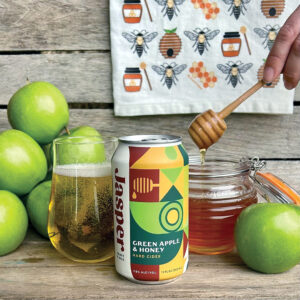
Jasper Winery raises a majority of its revenue through events, but that hasn’t stopped it from getting creative with drink offerings. Photo courtesy of Jasper Winery
Wineries do have the upper hand on event space. Jasper Winery’s ability to host weddings, bachelorette parties, wine tastings and major events like their summer concert series means a ton of business for the winery.
“Having those events definitely brings people in, and then afterwards they stay and enjoy a bottle or take a bottle to go,” said Jasper Winery Events Director Sydney Tallman. “About 60% of our business would be the events, and the other 40% would be the winemaking.”
Iowa Distilling Company (IDC), located south of Des Moines in Cumming, has been doing its best to keep up with the people of Iowa in its own way. The distillery ranks sixth among top native suppliers by gallons. Owner Kyle Doyle and Marketing Director Brooke Avila explained what they have done to keep up.
Iowans seem to be a fan of what they make. Prairie Fire and their Saints N’ Sinners whiskey are both in the top 10 brands ranked by gallons sold in 2023.
Doyle places a huge amount of importance on keeping Iowa dollars inside Iowa’s borders.
“You can find the IDC footprint in all 99 of Iowa’s counties,” he said.
A problem IDC faces, though, is competing with craft breweries, as there are more than 115 in Iowa compared to approximately 25 craft distilleries.
“We’re a small group, but we’re a mighty group,” Avila said.
Cannabis infused drinks
Part of the decline in alcohol sales may be the result of a recent emergence in non-alcoholic and cannabis-infused beverages. Many options are now available.
“You can get your brown goods, your vodka, or you might have a whole section of nonalcoholic or cannabis or other kinds of beverages that are nonalcoholic. People are choosing different things,” Bertram said.
Products that include cannabis have been a topic of debate in Iowa lately, whether it be inside the legislature or in the distilling room. Whether the laws change in Iowa or not, states surrounding Iowa have been loosening theirs. Iowa’s border states of Illinois, Missouri and Minnesota legalized the use of marijuana, Nebraska decriminalized it, South Dakota allows it for medicinal use, and Wisconsin allows CBD oils for medicinal use as well. All of these factors allow Iowans who don’t mind a short drive to have easy access to cannabis-infused beverages.
RJ Tursi is the owner of Exile Brewing, He has also noticed the uptick in local and national cannabis drinks, but he is not jumping on the bandwagon.
“As far as the cannabis-based drinks go, it’s not something that we’ve taken a serious look at,” he said. “I feel like there are a lot of people jumping into that right now because there is some success. For me, there’s still some questions there, and I don’t know that we want to get into the melee of everybody reaching for their share. I’d rather focus on what we’re doing and try to grow some of our other brands.”
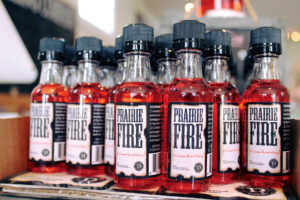
The Prairie Fire Minis are one way Iowa Distilling Company has changed the format of one of its best sellers. Photo courtesy of Iowa Distilling Company.
Doing what you do best
Iowa Distilling’s staple spirit is Prairie Fire, a cinnamon-flavored whiskey that Doyle compares to hot tamales candy or Big Red chewing gum.
“They trust the fact that we put out these quality spirits,” Avila said. “People look for it on the shelf (Prairie Fire) and call us saying, ‘Hey, we can’t find it at XYZ’ and I’m like, ‘Let me look it up.’ We have a search tool on our website, and I can tell them, ‘You can get a bottle just down the road.’ ”
Doyle says what they try to focus on at IDC is “becoming the best of the core.” As enjoyable as it could be to try out different flavors and ideas, they find it is most important to stick to what they do best.
“You don’t see a whole heck of a lot of crazy flavors that are coming out of here because we can have a new one every week. There are trends and there’s data and there’s what’s going to be the next greatest, latest whatever it is, but we want to be that base in everybody’s home bar, that our spirits are going to be their core,” Doyle says.
He adds, they do experiment and try their hand at other flavors and out-of-the-box ideas, but they understand that a home bar is always going to have the staples — a vodka, a bourbon, a whiskey, etc.
Trying to master that balance of what’s coming up next and what people want right now is a challenge for many distilleries.
“One of the things that everybody always talks about is innovation. And we have a lot of it,” Doyle says. “But the other aspect of it is the current need, and our stills have been running crazy for the last several years because we can’t keep up with demand for bourbon. It’s one of those things where we go, OK, if we have our stills running constantly with bourbon to try to match the demand for it, do we really want to take those stills off to create something else that might be awesome?”
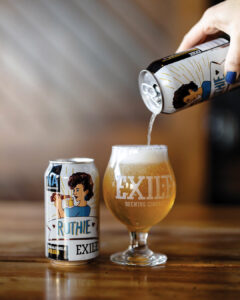
Ruthie NA is one of the ways that Exile Brewing has been able to tap into a generation of young people who aren’t drinking as much as those before them. Photo courtesy of Exile Brewing.
For Tursi and Exile, their staple is their pale lager, Ruthie, found on taps across Des Moines’ bars.
“Ruthie has been our best-selling beer for over a decade and, you know, that wasn’t really riding a trend when it became that. When we opened here to Exile, the West Coast IPA was kind of like the big trendy beer. And you saw a couple of local beers rise with that, and then the trends switched to Hazy IPA,” Tursi said.
At Jasper, the signature wines have won awards for years in the Des Moines area and have received mentions in the New York Times. However, it’s their sangria they’ve seen the most success with lately.
“People know us for our sangria,” Tallman said. “That’s going to be our top seller for our concert series. Everyone comes for a cold glass of sangria. But for our bottles, it’s our Behind The Shed Red. That’s our medium bodied, dry red. That’s our signature blend.”
Changing with the times
Knowing what customers like is key to growing a brand, but noticing the trends and hopping on them can be equally important.
“The hard seltzer trend came in and kind of flanked the whole category and was pretty insane. And then hard seltzers got flanked by the vodka sodas,” Tursi said.
While Tursi decided not to take part in the hard seltzer boom, he decided to try his hand at vodka sodas.
“We started doing vodka sodas in the summer of 2022,” he said. “There had been the seltzer trend, then the vodka soda trend started and we said, OK, let’s jump on this one, because we thought that High Noon was putting out a good product, and it was clear that they were starting to run away with it.”
For IDC, when making a product like bourbon that has to be put away for two years to age before they can touch it, planning ahead can be difficult. As a result, they might not come out with an entirely new flavor profile, but, more likely, a new format. Their mini–Prairie Fire isn’t a new flavor, but it gives a new, dynamic and different way to consume one of their flagship liquors.
Jasper Winery has experimented with changing their format by offering three wines, their ciders and sangria in a can.
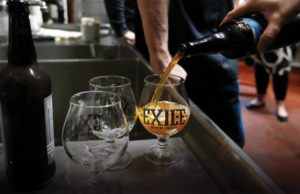
Exile Brewing has been opened since 2012 and has kept up with the trends by partnering with an NIL collective, making vodka sodas and twists on their bestseller. Photo courtesy of Exile Brewing
“Cans have been a huge trend,” Tallman said. “Just having something a little bit more convenient so people can drink them on the patio without having to open and bring glassware for a full bottle. That’s something we’ve seen a huge increase in and have added to our traditional lineup.”
Jasper Winery also planted its apple orchard in March of 2023. It has produced some apples but not enough yet for a full batch. Since years are needed for an orchard to produce a crop large enough for big batches of ciders, planning ahead can be all the more challenging, much like IDC with needing its bourbon to age.
“A lot of people associate cider with beer, just because a lot of breweries offer cider. But it’s very similar to wine in the way it’s made,” Tallman said. “It’s just a fermented fruit product similar to wine. So, we got interested in that just because we have all the equipment here to make it.”
Wine isn’t something that experiences many changes with exotic, wacky flavors like seen in beers or liquors. So, what needs to happen for people to keep coming back to fill their glass?
“One thing that we’ve been starting to do as well is really having more fun, unique products. With beer, they have the flavored stouts and sours. Our wine aged in bourbon barrels are just a little bit different. Just adding those fun twists on traditional wine has been fun. Our customers who come back all the time have something a little bit different that keeps them coming back,” Tallman said.
The ripple effect of name, image and likeness
In 2021, the NCAA loosened its name image and likeness rules, allowing college athletes to profit from their own personal brand. With schools needing to find clever ways to bring money in to help retain or attract athletes, two Iowa universities turned to alcohol and IDC and Exile.
IDC is the maker of Iowa State 1858 Vodka. ISU approached the distillery with this opportunity, much to the delight of Doyle.
“We were able to team up with them and become the first in the country to actually team up with an athletic department and a collective,” Doyle said.
This provided the distillery a chance to not only help their business but also a university the staff cherishes.
“Being able to get Iowa State fans to say, ‘Hey, let’s support your alma mater and also support local,’ ” said Doyle.
Unlike IDC, which was approached by ISU, Tursi pitched Exile to the Swarm collective. That partnership has proven to be successful so far, but Tursi says it can improve.
“I think we’ve sold around 30,000 cases so far. We want to sell a lot more. And, we’re going to be releasing a blackberry lemon Swarm vodka soda,” Tursi said.
Tursi says the idea came to him from other Iowa Hawkeye fans while he was attending tailgates during football season. He hopes to have it released by July 4.
What’s on the horizon?
Tequila has clearly replaced bourbon as the fastest growing spirit in Iowa.
Tursi has noticed that tequila is rising, but he says it’s not always as simple as seizing on what’s popular.
“We would love to get into tequila. We just had such a problem sourcing it,” he said. “The price of it was so expensive. We can’t charge what we would need to make this thing worth it.”
Data shows that today’s younger population is not drinking alcohol as much as prior generations did. According to Gallup’s ongoing research into alcohol consumption, those aged 18-34 who responded “yes” when asked, “Do you have occasion to use alcoholic beverages such as liquor, wine or beer” dropped from 70% to 62% since 2003.
While craft beer has been a successful industry, Tursi also sees the current younger generation of drinkers shrinking, and he says that could continue. The challenges that Exile faces don’t only come down to what they’re making, but also are related to who is going to be around to buy their products.
“You have a whole generation that’s getting older, and it’s a big generation (population wise). They’re drinking less because of that. Then the generation that’s replacing them is a much smaller group, and they’re not drinking as much in that smaller group. Just demographically, there’s big challenges there. So, does that younger group want to drink something local? I sure hope so,” Tursi said.
When it comes to those new ideas, Tursi says it is important that they put enough money and marketing behind a new product if they plan on doing a wider release, versus something they would put on their taps in house. At the moment, they do have a twist coming on a classic.
“We are excited about the pumpkin spice Ruthie, which we’re going to be coming out with,” Tursi said. “We’re going to be leaning even harder into our Halloween pop-up this year. We just feel like pumpkin spice Ruthie would be a knockout for that. We think that’ll be a lot of fun.”
Keeping an eye on what’s trending is vital to any industry, but figuring out the “why” behind the trend is equally important.
“It can be challenging to really nail it when you’re chasing a trend but, it happens,” Tursi said. “One of the things that you have got to be aware of, and you really have to try and distinguish, is why it’s trending. Is it just because a brand is crushing it right now? And if it’s more, then how can you take it away from them?” ♦


















